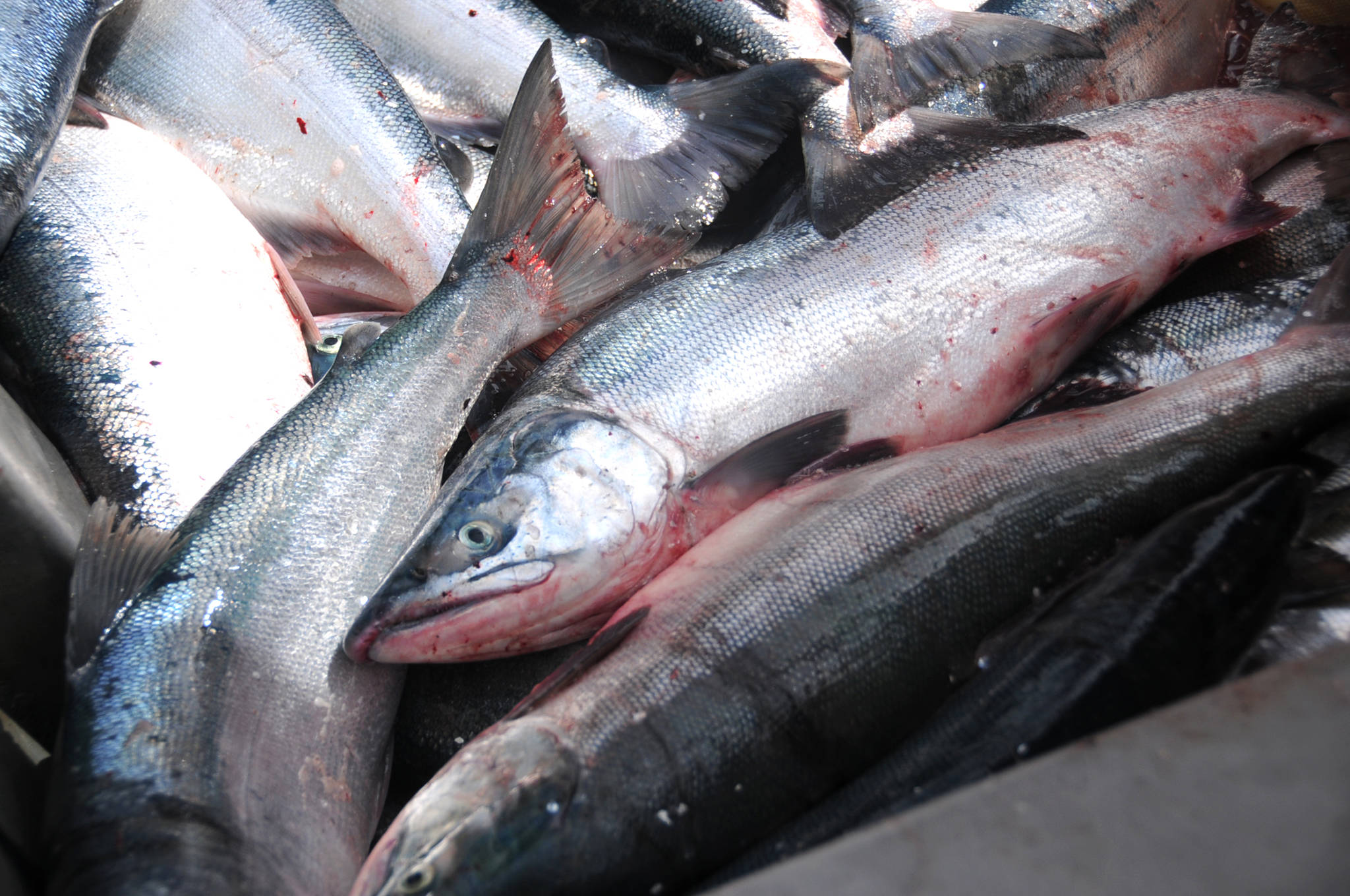Editor’s note: This article has been updated to clarify that the comment period offered on the federal rule regarding halibut catch limits is post-promulgation.
If forecasts hold true, 2018 will be a slower year for commercial salmon fishermen across the state.
The Alaska Department of Fish and Game is projecting commercial salmon harvests to be smaller than they were last year, particularly for pink salmon. All told, commercial fishermen are expected to harvest 148.9 million salmon, the majority of which are pink and sockeye salmon. That’s half as many pink salmon as harvested in 2017, about 1.8 million fewer sockeye, 3.9 million fewer chum and 581,000 more coho. Overall, commercial fishermen are expected to harvest 99,000 king salmon outside Southeast Alaska.
The biggest drop is in pink salmon, typically the most numerous fish harvested by commercial salmon fishermen. In 2017, fishermen landed 141.6 million pinks, worth about $169 million. This year, Fish and Game is forecasting a harvest of about 70.2 million pinks. That’s in part due to the smaller than expected pink salmon returns in 2016, leading to fewer fish spawning and thus a smaller cohort of adults to return in summer 2018, according to the forecast. Pink salmon also largely operate on a two-year cycle, with the biggest returns in Alaska arriving in odd-numbered years.
The chum salmon harvest was especially large in 2017, with the exvessel value for chum coming second highest since 1975, according to an Oct. 3, 2017 news release from Fish and Game. The sockeye harvest in Bristol Bay was large as well, though other regions — including Cook Inlet and Southeast Alaska — had below-average years for sockeye salmon, though Cook Inlet’s sockeye harvest came out greater than the preseason forecast predicted. Stronger coho returns marked most salmon fisheries as well.
Upper Cook Inlet’s salmon fisheries are primarily reliant on sockeye and coho salmon, with a higher harvest of king salmon in the shore-based set gillnet fisheries. Commercial fishermen also catch a smaller proportion of pink salmon and chum salmon before the areas with the most fishing effort close on Aug. 15.
Fish and Game has forecasted approximately 4.6 million sockeye to return to Upper Cook Inlet stream systems, with about 1.9 million in commercial harvest, about 900,00 fewer than the recent 20-year average, and 700,000 in other harvests, according to the forecast.
Fishermen are somewhat able to prepare for the highs and lows on the pink salmon two-year cycles, said Garrett Evridge, an economist with the McDowell Group, an economics consulting firm.
“I would say that the industry has responded to that, has worked on that, and kind of works on a two-year cycle to compensate for that,” he said. “We don’t really see these massive swings in exvessel values on a year-to-year basis because those supply fluctuations are already baked into the price.”
A weaker salmon year adds to the poorer forecasted year in a number of commercial fisheries around Alaska. Though the International Pacific Halibut Commission did not arrive at new regulations for halibut catches in 2018, leaving the quotas where they were in 2017, both Canada and the U.S. “indicated their intention to pursue lower catch limits for 2018 via domestic regulatory processes,” according to a meeting summary from the International Pacific Halibut Commission. The National Marine Fisheries Service has reduced catch limits for halibut in both the commercial and charter fisheries across the regulatory areas of the west coast and Alaska. The total catch limit across the state would call about 9.3 percent, according to the proposed rule in the federal register. Comments post-rule promulgation are open until April 19.
Even if the restrictions are imposed, though, the halibut spawning stock biomass is still expected to drop over the next three years, according to the proposed rule. There is also a chance that by 2021, the spawning biomass stock will be so reduced that the International Pacific Halibut Commission will have to substantially reduce the commercial halibut fishery under an interim management process, according to the rule.
Halibut is a hard market to be in at present, Evridge said. With season open since last Saturday, fishermen are seeing prices about $2 lower than they were this time last year. A number of things could be affecting the price, one of which is just market fatigue with the high prices of Alaska halibut and higher catches of Atlantic halibut.
“There’s a tension between that price and that demand,” he said. “It’s something that you run across in all different species … As salmon prices appreciate, everybody’s like, ‘Hurrah, hurrah,’ but at the same time you’re kind of cutting out the individuals who can’t afford salmon. That could be a factor on the halibut side that you’re really reaching that level that cuts your market penetration.”
Pacific cod fishermen will also take a hit this year. The North Pacific Fishery Management Council decided in December 2017 to reduce the Gulf of Alaska Pacific cod quota by 80 percent for 2018 in response to concerns about stock recruitment. Gov. Bill Walker and Lt. Gov. Byron Mallott requested a fishery disaster declaration from the U.S. Department of Commerce because of the reduction.
Evridge said the market could be somewhat positive for whitefish prices, which include Alaska pollock and Pacific cod, and despite the smaller predicted harvests could be better for salmon. Farmed salmon prices are also strong right now, which narrows the price gap between Alaska salmon and farmed Atlantic salmon.
“Going back to your supply and demand paradigm, strong farmed salmon prices are probably a good thing for Alaska right now,” he said. “You want to avoid a situation in which Alaska salmon is a lot more expensive than farmed salmon.”
Reach Elizabeth Earl at eearl@peninsulaclarion.com.

